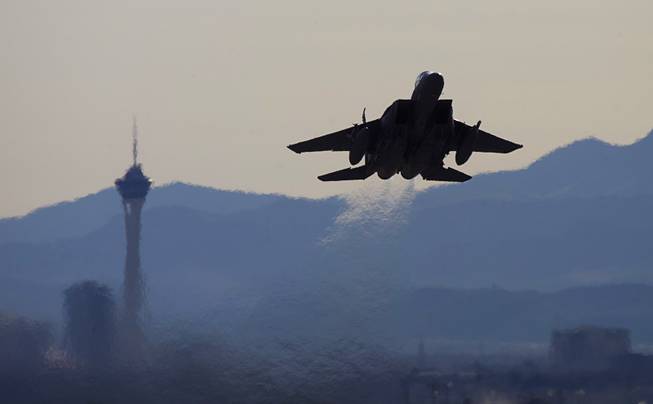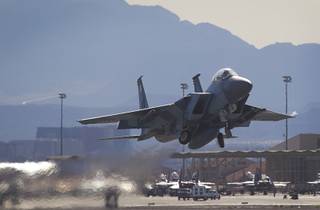
An F-15 fighter jet takes off during Red Flag 13-3 exercises at Nellis Air Force Base Wednesday, Feb. 27, 2013.
Saturday, Aug. 3, 2013 | 2 a.m.
Help wanted: At least 130 veteran military aviators for a nine-year commitment to fly fighter jets.
Salary: Pay range $34,500 to $97,400. Plus good benefits and a $225,000 signing bonus — guaranteed.
Contact: U.S. Air Force by Sept. 30.
That’s the offer from the Pentagon, which is so short of Air Force fighter pilots that it’s boosting its salary package to make the job more enticing.
It may be hard to imagine that life as a high-flying fighter jock has lost its swagger, but the Air Force revealed it has a shortage of 200 fighter pilots this year. And if something isn’t done, the Air Force, which has about 3,000 fighter pilots, fears it may face a shortfall of 700 by 2021.
And that figure — 700 — would be significant for the Air Force, according to Brig. Gen. Charles Moore at Nellis Air Force Base.
“That starts to have mission impact and brings in a question: Can we complete a mission?” Moore said. “Doing nothing is not an option. We have to figure out how to maintain those folks and experience. It is absolutely critical.”
Empty cockpits are bad news for the military, which is shoveling money into the development of the world’s most expensive program, the F-35 Joint Strike Fighter jet — expected to cost nearly $400 billion. The cost is a double whammy for taxpayers because the Air Force said it costs taxpayers about $6 million to train a fighter pilot.
Several factors are behind the exodus of pilots, officials said, including a surge in demand for better-paying commercial pilots, the stresses of deployments and reassignments to fly combat drones, the remote-controlled technology that has reshaped modern warfare.
As a result, the Air Force is offering a souped-up incentive package under something called the Aviator Retention Program, which was first rolled out in 1989. The program now offers a $25,000 signing bonus per year for nine years — nearly twice as long as the usual contract.
“Were it not for the program, there would be a greater problem than the one we currently have,” said Lt. Col. Kurt Konopatzke, who oversees the program. “Senior leadership is aware of the problem and is very concerned.”
The Air Force wants to get as many of the 200 to 250 eligible fighter pilots to take the deal. Some have signed on.
Today, just 65 percent of pilots are deciding to extend their service past their 11th year, when they choose whether to stay for an additional five years. That’s compared with 80 percent in 1993.
Moore said that for this group of pilots, the decision on whether to continue includes personal considerations.
“Most of these folks are hitting their activity duty date, which is 10 years after they graduate from flight school. They’ve known nothing but war. ... There is fatigue out there, and they start to have children, or get older and are trying to determine what is best for the family.”
Sequestration has had an effect as well, Moore said.
“About one-third of the fighter squadrons are grounded. They joined the force to do the job, and I don’t think that has been necessarily a good experience for a lot of them, and I know it has not been a good experience for us at Nellis.”
Air Force pilots typically earn about $90,000 by the time they complete their 11th year. The median annual wage of airline pilots, co-pilots and flight engineers is $103,210, according to the U.S. Bureau of Labor Statistics’ latest numbers.
There have been fighter pilot shortages in the past, but the competition promises to be fierce in the years to come as airlines hunt for young talent because of a surge in retirements.
Last year, passenger jet maker Boeing Co. released a report that estimated a global need for 460,000 new commercial pilots over the next two decades. There are more than 71,000 active airline pilots in the United States.
Neither US Airways nor American Airlines, which are in the middle of merging, has hired pilots in more than a decade. Each is beginning a large-scale recruiting effort to fill spots.
US Airways and American are anticipating the retirement of more than 2,100 pilots within the next five years because of the mandatory retirement age of 65.
“The airlines are going to have more money to pay for pilots than the government,” said Rob Streble, 52, secretary and treasurer for the US Airline Pilots Association, a labor union that represents US Airways pilots.
Another reason military pilots will be hotly sought after is a new Federal Aviation Administration rule that substantially raises the qualification requirements for first officers who fly for U.S. passenger and cargo airlines.
It requires commercial co-pilots to have 1,500 hours of flying experience, the same as captains. Currently, first officers are required to have only a commercial pilot certificate, which requires just 250 hours of flight time.
Sun reporter Brian Nordli contributed to this story.


Join the Discussion:
Check this out for a full explanation of our conversion to the LiveFyre commenting system and instructions on how to sign up for an account.
Full comments policy